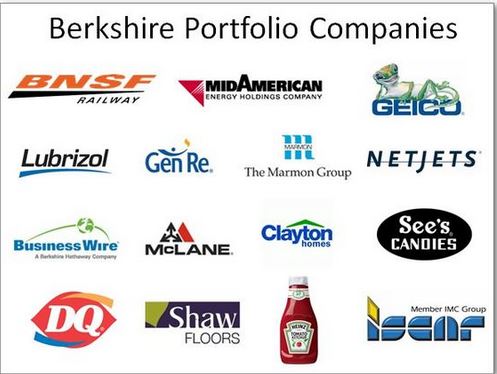 In our most recent prior article https://www.markettamer.com/blog/does-the-oracle-of-omaha-have-an-achilles-heel we highlighted the ongoing frustration that grips the majority of U.S. investors – underperforming the average equity mutual fund. These investors underperform “the Market” for a variety of reasons – reasons often catalogued in detail by “Behavioral Finance” articles that pop up in the mainline press[1] quite regularly. However, the overriding cause of underperforming “the Market” resides in common human emotional vulnerabilities that prompt us to make counter-productive investment decisions.
In our most recent prior article https://www.markettamer.com/blog/does-the-oracle-of-omaha-have-an-achilles-heel we highlighted the ongoing frustration that grips the majority of U.S. investors – underperforming the average equity mutual fund. These investors underperform “the Market” for a variety of reasons – reasons often catalogued in detail by “Behavioral Finance” articles that pop up in the mainline press[1] quite regularly. However, the overriding cause of underperforming “the Market” resides in common human emotional vulnerabilities that prompt us to make counter-productive investment decisions.
Potential remedies to counteract those vulnerabilities include:
1) Following a disciplined plan based on a tested strategy;
2) Investing in an index fund;
3) Following the lead of a proven “Market Master”, such as Warren Buffett.
For his part, Buffett has demonstrated an affinity toward large cap, blue-chip stocks. In fact, the largest positions in his Berkshire Hathaway (BRK.A) portfolio fall into that category….. such as Wells Fargo (WFC), Coca Cola Co (KO), American Express (AXP), and IBM (IBM). In fact, those four positions along constitute almost 63% of his portfolio (62.86%). The next six stocks in the portfolio’s “Top Ten” only account for 19.83% of total portfolio assets.
However, as our earlier article illustrated with regard to his 2011 investment in IBM… staking one’s money on a blue-chip is hardly a guarantee of avoiding messy losses. Obviously, Buffett placed too much trust and too much money upon the (then shifting) management of so-called “Big Blue”.
So perhaps it is worthwhile to take a look “under the hood” of the BRK.A portfolio to identify some smaller positions that might over an insight about Buffett’s investment principles… as well as a potential opportunity for us to garner some investment gain!
First, let’s consider one of the “teaching points” Buffett referred to in his March 2015 “Shareholder Letter”:
“If you aren’t willing to own a stock for 10 years, don’t even think about owning it for 10 minutes.” — W. Buffett
His eighth largest position is in DaVita HealthCare Partners (DVA) – 2.67% of the portfolio. DVA is the result of a merger between DaVita and Health Care Partners… two distinctly different segments of the “Health Care” space.
Unlike companies in the volatile “Biotech” space, DaVita offers a tamer, steadier business model – providing one of the United Stares’ largest networks of kidney dialysis services:
And for its part, HealthCarePartners manages and operates medical groups and affiliated physician networks in four Western U.S. states and Florida – touting their “innovative models of healthcare delivery.”
As with the health care space in general, DVA is positioned to benefit from the demographic trend toward an older populace (Baby Boomers) who will naturally provide growing demand for health providers – particularly in the West and South (such as Florida).
If that is not enough to enthuse you about DVA, it is also involved with 87 international partnerships (China, India, Germany, the Middle East) and through a partnership with Centura Health[2], it is becoming involved is the hospital business.
Here is a two-year chart of DVA (revealing a classic lower left/upper right trend):
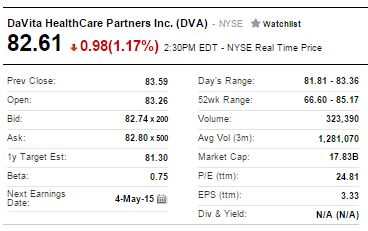 As you can see in the “Summary” of DVA, the stock is in no way “undervalued”… but it does sport a great story, is riding a solid trend, and is positioned in a space benefiting from “tailwinds” that will surely continue over the next 5-10 years.
As you can see in the “Summary” of DVA, the stock is in no way “undervalued”… but it does sport a great story, is riding a solid trend, and is positioned in a space benefiting from “tailwinds” that will surely continue over the next 5-10 years.
As we have seen with IBM, not all of Buffett’s stock positions are what one would call “classic buys” at the moment. As we know, Buffett has a very long-range investment perspective … with his favorite “hold” time being “forever”. So let’s look at one stock that he held through what could only charitably be called a “rough patch”: Chicago Bridge & Iron Company N.V. (CBI). (CBI is about 0.41% of the Buffett portfolio).
This stock illustrates an investment principle that Buffett describes as:
“Be fearful when others are greedy; be greedy when others are fearful.”[3] — Warren Buffett
CBI is a 136 year-old company that is now headquartered in the Netherlands. It is an expansive industrial concern that includes these business segments:
Engineering, Construction, Maintenance – involved in projects related to the electric power industry, as well as the oil and gas industry.
Fabrication Services— the fabrication of pipes, fittings, nuclear modules, and steel plate structures.
Technology — provides licensed process technologies; catalysts; and engineered products, including heat transfer and proprietary equipment
Environmental Solutions – for both private-sector and government customers, including disaster recovery and the remediation/restoration of contaminated sites… as well as more standard “design-build” infrastructure projects.
Here is the company’s the 2-year stock chart:
Between April of 2014 and early February of this year, CBI suffered from negative sentiment and a huge slide in price. Much of the market negativity was focused on sliding energy prices… but in addition, accounting and cash flow concerns related to the $3 billion acquisition in 2012 of the Shaw Group impacted the stock
However, the Shaw acquisition has significantly enhanced CBI’s competitive position vis-à-vis attracting clients in the government and energy company spaces. Just last week (April 23) the company reported its latest quarterly earnings … including a $30 billion order backlog!
“net income for the first quarter of $132.2 million, or $1.21 per diluted share, an increase of 40 percent against adjusted net income for the comparable period. Revenues for the first quarter were $3.1 billion, up from $2.9 billion, or 7 percent from the first quarter 2014. New awards for the first quarter totaled $3 billion, which resulted in a backlog of approximately $30 billion.
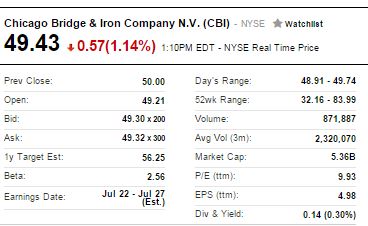 As you can see in the “Summary”, CBI sports a P/E Ratio of less than 10! It recently reflected a Price/Earnings-to-Growth Ratio of 0.62. That places CBI within the category that most analysts would describe as “relatively cheap”. As the chart shows, the stock seems to have regained its traction since February (benefiting from higher oil prices, among many other factors).
As you can see in the “Summary”, CBI sports a P/E Ratio of less than 10! It recently reflected a Price/Earnings-to-Growth Ratio of 0.62. That places CBI within the category that most analysts would describe as “relatively cheap”. As the chart shows, the stock seems to have regained its traction since February (benefiting from higher oil prices, among many other factors).
Finally, let’s take a look at USG Corporation (USG)… a 114-year old U.S. company[4] based in Chicago.
In December of 2013, Buffett became the biggest shareholder in USG by converting the convertible notes he acquired in 2008 into common stock shares. (USG accounts for about 1% of the holdings in BRK.A.)
Originally known as United States Gypsum Corporation, this company produces construction materials – principally drywall and joint compound. USG is the biggest manufacturer of gypsum products in North America and the largest distributor of wallboard in the U.S.
USG is illustrative of one of the other teaching points referred to by Buffett in his March letter:
“Our approach is very much profiting from lack of change rather than from change.” — Buffett
Depending upon one’s view of the U.S. economy and the housing market, USG could ride some tailwinds if/when the economy more fully “takes off” and approaches the “typical” scale of past U.S. recoveries from recession!
USG management is focused upon what it describes as three “strategic priorities:
1) Strengthening the core of North American manufacturing and distribution,
2) Innovation, and
3) Diversification into emerging markets and related products.
With regard to the third strategy, USG has partnered with Boral Ltd. (an Australian company) in a joint venture[5] intended to expand its markets into Asia, Australia, and the Middle East.
Here is the 2-year stock chart for USG:
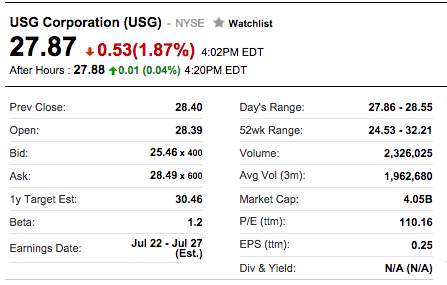 As you see, it has lately been range-bound. One analyst recently reported that the Price/Earnings-to-Growth Ratio was a paltry 0.45 – which if projections pan out would mean that USG stock is currently significantly undervalued.
As you see, it has lately been range-bound. One analyst recently reported that the Price/Earnings-to-Growth Ratio was a paltry 0.45 – which if projections pan out would mean that USG stock is currently significantly undervalued.
INVESTOR TAKEAWAY:
As we all know from experience, the popular press focuses almost entirely upon Buffett’s large cap, blue chip positions – and/or those that make for “flashy headlines”, such as the takeover of Kraft Foods by Heinz (https://www.markettamer.com/blog/is-this-the-new-buffett ). Despite that the fact that our Market Tamer readers are inordinately astute and well read, I imagine that a majority of folks reading this most likely did not know much about DVA or CBI… and likely forget that USG is owned by Buffett! And as I have shown, those positions are quite different in both nature and price patterns. They certainly offer great illustrations for several of Buffett’s March Shareholder Letter teaching points.
Some of our readers might be attracted to using these three stocks as trading vehicles. And once again, each one presents different opportunities for the use of a variety of trading strategies.
For example, DVA might be appealing as an opportunity for a Covered Call. For example, at the close of trading on April 30 you could have placed a limit order to purchase DVA and sell a July 85 Call for a net debit of $80.00. The recent high was just a bit over $85, so that covered call offers a trader shares of a strong Buffett holding, with the prospect of profit if it moves to a new high (at which point she/he could sell a $82.50 (or lower) Put to regain the (likely) “called away” stock. If the stock stalls and doesn’t exceed $85 by the July expiration date, the trader pockets the call premium and can sell another further our Call.
On the other hand, if a trader is attracted to DVA prefers buying at a lower price, a July $80 Put would sell for $1.80 – meaning the trader would buy it for $78.20 if the stock price falls off. That is a hefty discount vis-à-vis the 4/30 closing price of $81.10. And if the stock plateaus or appreciates, the trader gets to keep the $1.80!!
The stock of CBI would be a good candidate for strategies that are useful in trading stocks that have “based” at support and hold the promise of trending up or plateauing. A trader could sell a July $40 Put at a $2.15 limit price and possibly keep the premium if CBI remains above $40… or get a great price ($37.85) on CBI.
And for USG… range-bound as it has been … appropriate strategies could include an Iron Condor (straight up or “legging in”) or watching the stock chart relative to Bollinger Bands or a Keltner Channel (selling at the top of the channel and buying toward the bottom).
Finally, as a “bonus” (and as long as we’ve been dwelling on “all things Buffett”) I thought you might find it of interest to review the current status of a market “value indicator” frequently referred to as Buffett’s “favorite indicator”[6]: The Ratio of Total Market Cap over GNP.
Historically the ratio has only been higher than it is now during the “Tech Bubble” of 2000. That might surprise you, since most folks might assume it would be higher in 2007. However, remember that in that instance, the “Crash” was Collateral Damage from the utter collapse of an overly leveraged financial system… not directly as a result from a market “bubble” per se! This “Historical Mean” of the indicator is approximately 85%!
Before I wrap up I must emphasize… in bold font… that the elevation of this indicator does not, in any way, suggest an imminent fall in stock prices. First, far too many other variables are at play (the Fed being the biggest). But second, the market can stay “over valued” for extended periods of time!
DISCLOSURE:
The author does not currently own DVA, CBI, or USG. Nothing in this article is intended as a recommendation to buy or sell anything. Always consult with your financial advisor regarding changes in your portfolio – either subtractions or additions.
FOOTNOTES:
[1] And are available via the Internet
[2] Based in Colorado
[3] This is Buffett’s more palatable paraphrase of the infamous quote from Baron Rothschild:
“Invest when there is blood in the streets.”
[4] According to Wikipedia, it was founded in 1901.
[5] A 50/50 venture
[6] So referred to because of this Buffett quote: “the best single measure of where valuations stand at any given moment,”
Related Posts
Also on Market Tamer…
Follow Us on Facebook

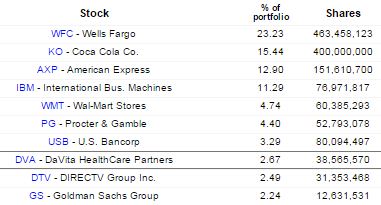
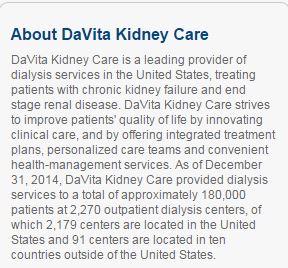


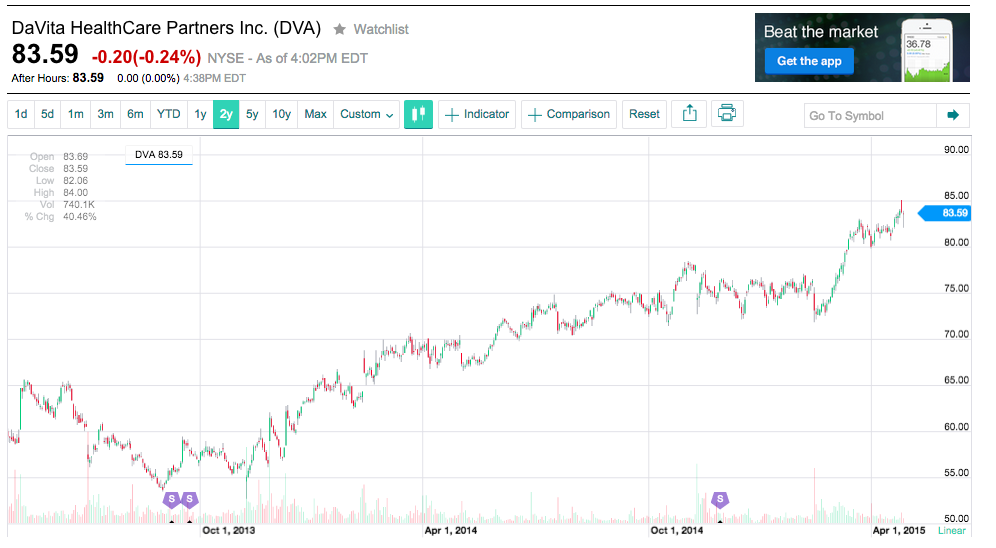

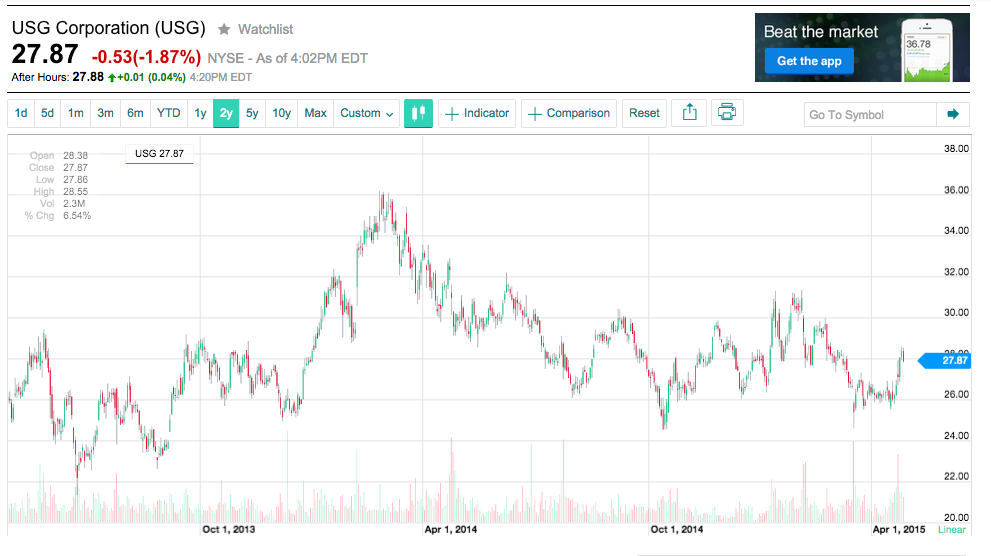
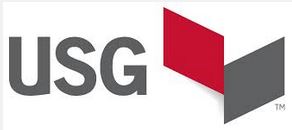
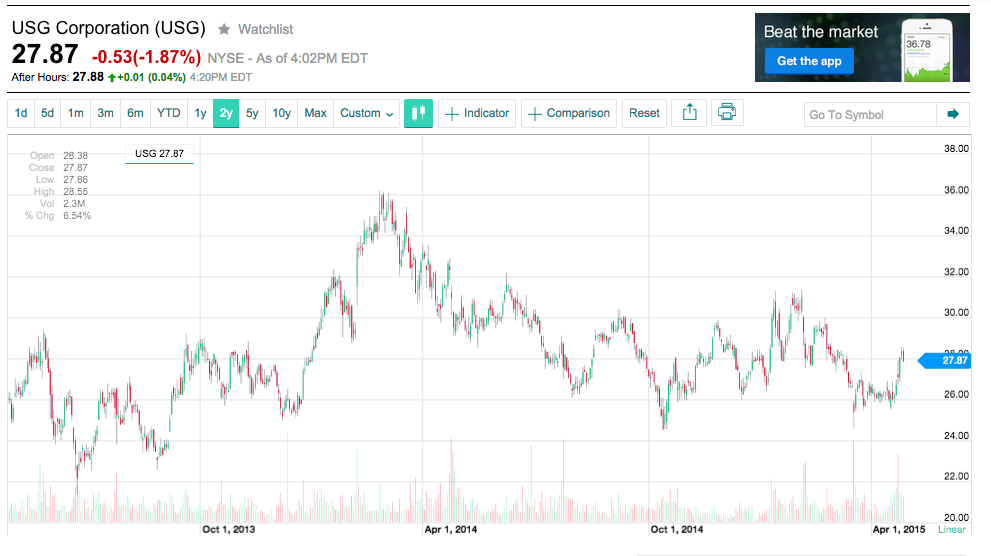
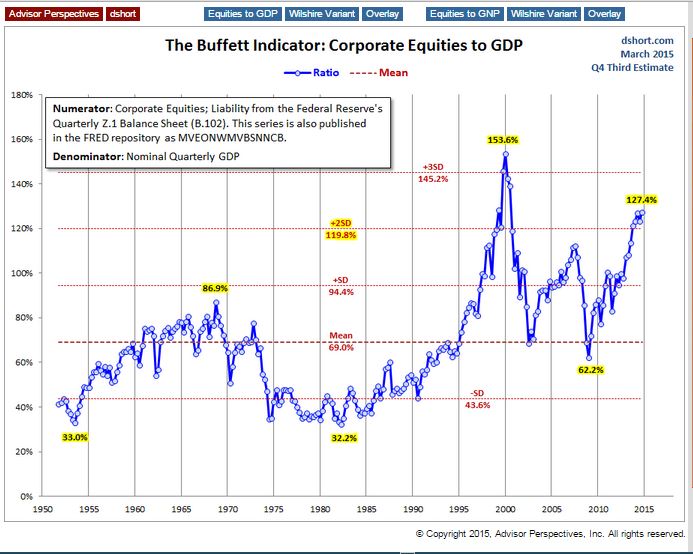
 You Don't Need Talent to Succeed: Lessons From Warren Buffett's Lifetime of Investing
You Don't Need Talent to Succeed: Lessons From Warren Buffett's Lifetime of Investing